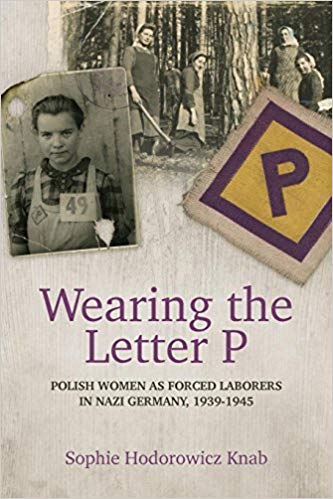Polokaust Passive Genocide and Wearing Letter P Knab

Wearing the Letter P, by Sophie Hodorowicz Knab. 2016
Parallelism Between the Experiences of Poles and Jews in Nazi Germany. Forced Labor as Passive Genocide–Part of the Polokaust
Author Knab cites German historian Ulrich Herbert. He stated that over 7.6 million foreign workers were registered for the territory of the Greater German Reich. Of these, 1.7 million were Poles (not including POWs), with over half of them female, and with an average age about twenty. (p. 36).
LIKE POLES LIKE JEWS
Although Poles and Jews were supposed to be “Unequal Victims” of the Nazis in the group sense, their respective experiences overlapped considerably. For instance, both had to wear humiliating identification. In March 1940, the March Decrees on Poles, the POLENERLASSE, had been enacted by the Nazi authorities. They required that Poles wear the “P”, be as segregated from Germans as possible, and be strictly forbidden to have intimate relations with Germans. (pp. 62-65; See also pp. 87-89). Not mentioned is the fact that the POLENERLASSE were parallel to the Nuremberg Laws for Jews.
A juxtaposition of the Polish and Jewish experience in Nazi Germany was recounted by a defiant Polish forced laborer—then 13 year-old Leokadia Dyczynska, “At the police station, they gave us the letter “P”, threatening us with heavy punishment if we failed to wear them on our breasts. The Jews have the star, we have the letter “P”. We are going to wear this symbol. We are not ashamed to be Poles.” (p. 63).
Another juxtaposition of Poles and Jews occurred as follows, “By December 1940, the Trustee for Labor ordered that ‘Poles, like Jews, should be excluded from receiving a Christmas bonus…’” (p. 115).
Some German physicians were so racist that they refused to treat Poles—in violation of medical ethics and the Hippocratic Oath. (p. 153).
The systematic degradation of Poles was intentional. It included Poles being housed with animals in barns. (p. 74).
PASSIVE GENOCIDE: REDUCING THE OVERALL POLISH BIRTH RATE
The Polokaust was both direct and indirect. The removal of Poles from German-occupied Poland was not done solely to satisfy the need for workers. It also served a passive-genocidal purpose: It reduced the population of young adult Poles of prime childbearing age. The foregoing consideration is not mentioned in this book, and I do so for the education of the reader.
Various measures then drastically reduced the birthrate among the deportees. In Germany, Polish forced laborers were not allowed to marry. (p. 182). Pregnant Polish women were often forced to have abortions (pp. 180-on), and no one knows how many Polish women thus lost their children. (p. 185). In addition, no one knows how many pregnant Polish women committed suicide. (p. 182). Infant homes were established for the care of Polish babies while their mothers worked. The infants usually died in a matter of a few weeks from neglect. The infant homes could have numbered in the thousands throughout the Third Reich. (p. 213).
To see a series of truncated reviews in a Category click on that Category:
- All reviews
- Anti-Christian Tendencies
- Anti-Polish Trends
- Censorship on Poles and Jews
- Communization of Poland
- Cultural Marxism
- German Guilt Dilution
- Holocaust Industry
- Interwar Polish-Jewish Relations
- Jewish Collaboration
- Jewish Economic Dominance
- Jews Antagonize Poland
- Jews Not Faultless
- Jews' Holocaust Dominates
- Jews' Holocaust Non-Special
- Nazi Crimes and Communist Crimes Were Equal
- Opinion-Forming Anti-Polonism
- Pogrom Mongering
- Poland in World War II
- Polish Jew-Rescue Ingratitude
- Polish Nationalism
- Polish Non-Complicity
- Polish-Ukrainian Relations
- Polokaust
- Premodern Poland
- Recent Polish-Jewish Relations
- The Decadent West
- The Jew as Other
- Understanding Nazi Germany
- Why Jews a "Problem"
- Zydokomuna